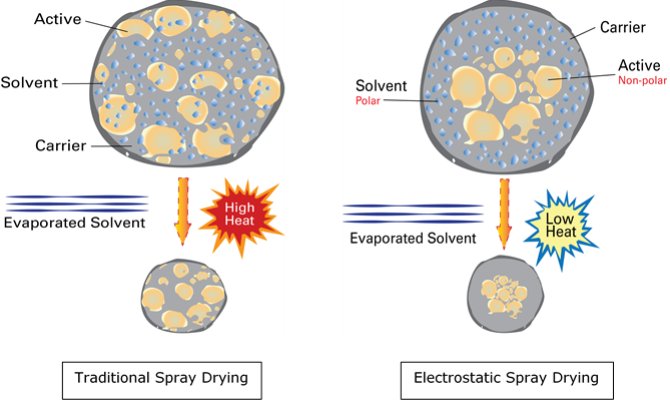
Project
Electrostatic spray drying of infant formula products
Introduction
Spray Drying is a versatile technique, not only for simply drying food materials, but also for specific objectives including microencapsulation, microbial inactivation, preservation, improved product characteristics, etc. However, several shortcomings are associated with spray drying processes, including the high-temperature requirement, which is not feasible for heat-sensitive materials such as volatile, bioactive compounds. Most heat-sensitive materials lose their action after drying or after only a few weeks of storage when spray dried. When dealing with high-value commercial products, compromise with quality particularly w.r.t. nutritional attributes is highly unacceptable. Infant formula falls into the category of products that require particularly high quality and availability of the nutrients included in it because it is often the only nutrient source for infants in absence of mother’s milk. Consequently, it must be ensured that infant formula has all of the nutrients required for healthy growth in sufficient quantities. Heat-sensitive components which are found in mother’s milk have also been included in commercial infant formulas e.g., lactoferrin, immunoglobulins, MFGM, DHA, etc. The retention of functionality of these compounds in infant formula post-processing has been drawing attention to researchers to date.
One of the emerging technologies in the food industry is electrostatic drying which dries the material at comparatively lower temperatures than the traditional spray drying process. Electrostatic spray drying is a process that involves applying an electrostatic charge to the feed solution to allow it to dry at lower temperatures than traditional spray drying. It works on the principle that the charge on the atomized droplets drives the most polar component of the feed to the shell i.e., the outer surface of the droplet and the least polar or active components to the core i.e., at the center, thus resulting in presence of higher amounts of water at the surface during droplet formation, in turn providing better drying efficiency at lower temperatures. Some studies recently which has used the concept of electrostatic spray drying to producenanoparticles, nanosuspensions, and microspheres forencapsulation. But seldom has investigated this technology as a focus on preserving heat-sensitive components.

Aim
This research aims to provide a fundamental understanding of the influence of product composition, ingredient interactions, and processing conditions on the electrostatic drying of (model) infant formula products and to explore if electrostatic drying of infant formula can be a viable alternative to conventional spray drying where high inlet temperatures are required.
Approach
The effect of electrostatic drying on the stability of protein-stabilized or emulsifier-stabilized emulsions in (model) infant formula will be studied and compared with the conventional spray drying. Retention of heat sensitive materials post drying will be in focus as it will be an important application for infant formulae specialities powders. Changes in structural and surface properties of the powder will be investigated in depth.